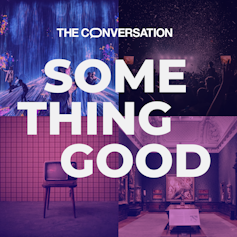Leap Year, a new exhibition of work by South Korean artist Haegue Yang at the Southbank Centre’s Hayward Gallery, is a bold and diverse display of contemporary art, mixing materials and ideas in unexpected ways.
Those with a knowledge of art history over the last 70 years will appreciate how Yang plays with and combines various art traditions. For example, her use of LED, neon strip-lights, steel, text, projected video and even smell are deliberate references to materials commonly used in contemporary art.
Yang’s art isn’t particularly “Korean”, but why should it be? Like many artists from around the world, Yang has been influenced by western pop culture. Coca-Cola and Hollywood movies have been as much part of life in South Korea since the Korean war as in Britain. While some see this as a downside of globalisation, many in South Korea embrace these influences, seeing them as a sign of progress. This fusion of cultures is a fact of life for Yang, and it runs through her art.
In the wall text at the exhibition, Yang claims to have developed a “culturally hybrid visual language”. Her work references modernism, minimalism and conceptual art. Large black-and-white photo collages that bring to mind early 20th-century dada art (a post-war movement that was anti-bourgeois and often satirical and nonsensical) provide the backdrop for sculptures mounted on wheeled frames, reminiscent of stage sets or even fairground rides.
Another resembles a shower cubicle, but with grab handles on the outside. The title, Sol LeWitt Vehicle, points to the conceptual artist Sol LeWitt. Geometric floor patterns recall the work of Gabriel Orozco, another well-known contemporary artist. In one room, the walls are painted in a blue that’s close to Yves Klein’s famous International Klein Blue (a shade of pure ultramarine he claimed to have invented and which features in his most famous works), although the paint was sourced locally by gallery staff.
Connecting with tradition
Yang is particularly interested in the ways contemporary art connects with older folk and craft traditions. For example, she explores weaving practices from different cultures, even working with Filipino artisans. These pieces sit alongside Reflected Red-Blue Cubist Dancing Mask, a sculpture that takes inspiration from how early cubist artists saw African masks as pure aesthetic objects, rather than ritualistic tools.
Yang’s interpretation has wheels and handles, allowing it to be worn and used performatively, restoring its function, but with a modernist aesthetic twist.
Her interest in folk traditions goes deeper. During the COVID lockdown in Seoul, she began exploring paper cutting, a traditional Korean craft often linked with shamanic rituals. From there, she expanded her research to include paper-cutting practices from other parts of the world, like wycinanki from eastern Europe and amate from Mexico.
In her Mesmerising Mesh series, she uses traditional Korean paper (hanji), as well as Japanese washi and graph paper, to create intricate collages. The wooden structures she builds around these works resemble shrines from different cultures. Though some viewers might think of them as something more familiar, like the decor in a western Chinese restaurant. In fact, these designs were inspired by the Hmong people of Southeast Asia.
In the west, since the second world war, the idea of universal art has often been viewed as tied to colonialism or cultural dominance, yet we embrace universal ideas like healthcare and human rights as progressive. Yang’s work suggests that art, too, has the power to bridge divides and foster empathy, breaking down barriers between cultures. Art may vary greatly across traditions, but at its core, it speaks to our shared humanity – a message as relevant as ever in our polarised times.
Haegue Yang’s Leap Year: Universal Art for a Divided World is on at the Hayward Gallery in London from October 9 2024 to January 5 2025

Looking for something good? Cut through the noise with a carefully curated selection of the latest releases, live events and exhibitions, straight to your inbox every fortnight, on Fridays. Sign up here.
Martin Lang does not work for, consult, own shares in or receive funding from any company or organisation that would benefit from this article, and has disclosed no relevant affiliations beyond their academic appointment.
This article was originally published on The Conversation. Read the original article.







